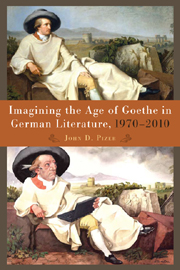Book contents
- Frontmatter
- Contents
- Acknowledgments
- Introduction
- 1 Staging Violence and Transcendence, Embracing Feminism: The Instantiation of Kleist and German Romanticism
- 2 Hölderlins East and West
- 3 Between Feminism and National Identity: The Historical Novels of Renate Feyl
- 4 Goethe Contra and Pro
- 5 Savaging and Salvaging the German Enlightenment
- Conclusion
- Bibliography
- Index
Conclusion
Published online by Cambridge University Press: 05 February 2013
- Frontmatter
- Contents
- Acknowledgments
- Introduction
- 1 Staging Violence and Transcendence, Embracing Feminism: The Instantiation of Kleist and German Romanticism
- 2 Hölderlins East and West
- 3 Between Feminism and National Identity: The Historical Novels of Renate Feyl
- 4 Goethe Contra and Pro
- 5 Savaging and Salvaging the German Enlightenment
- Conclusion
- Bibliography
- Index
Summary
Writers frequently look to authors from the past for inspiration, guidance, and, conversely, as foils against whom they develop new styles, techniques, political perspectives, and themes. As demonstrated by the essays collected in the volume The Author as Character, discussed in the introduction, imaginative writers often make their literary precursors into fictional characters in pursuing their own diverse agendas. In the realm of cinema, the popular success of films such as Shakespeare in Love (1998) and the recent Jane Austen biopic Becoming Jane (2007) show author-as-character movies can generate mass cultural appeal. Not all such fiction stays within the national or even linguistic bounds of authors and their historical subjects. The English novelist Penelope Fitzgerald, for example, published a novel on the German Romantic poet Novalis (the pen name of Friedrich von Hardenberg), the Blue Flower (1995), the title of which is derived from Novalis's celebrated trope in his uncompleted novel Heinrich von Ofterdingen (1801).
While author-as-character fiction is clearly transnational in scope, German fiction on the leading literary and intellectual figures associated with the Age of Goethe has proven to be particularly rich, dynamic, prolific, and cogent. Although works belonging to this subgenre have been in evidence since the eighteenth century itself, when Lenz and Goethe portrayed their contemporaries by name in minor theatrical pieces, and prose of this sort by Büchner and Thomas Mann achieved canonic status, only since the 1970s has a wide-ranging and critically acclaimed body of such imaginative writing emerged. Eighteenth- and early nineteenth-century German authors were made fictional characters in these works to serve a variety of purposes, as was the case in such fiction prior to the 1970s, but one can nevertheless discern certain tendencies within the corpus examined in this book that allow it to emerge in its discrete and cohesive character.
- Type
- Chapter
- Information
- Imagining the Age of Goethe in German Literature, 1970–2010 , pp. 187 - 192Publisher: Boydell & BrewerPrint publication year: 2011



